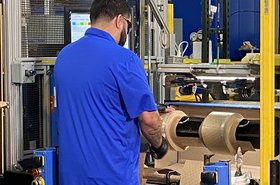With an increasing number of data centers moving away from traditional sources of power toward a more sustainable approach, operators are constantly looking for ways to ensure that this new reality brings the same opportunities for safety, service, and value that both they and their customers demand.
In a recent DCD>Broadcast, held as part of Eaton’s Innovation Day, DCD spoke to Eaton’s Ed Spears, technical marketing manager, and Cyrille Brisson, global data center segment leader. Together, we explore the advancement in battery technology surrounding uninterruptible power supplies (UPSs), and how these monoliths of stand-by power can be put into everyday use to balance grid load, and even become an income stream for the center.
Whilst a lot of the technology that we are seeing in modern UPS systems isn’t new, it has taken the arrival of AI to find its “killer use case.” The idea to roll out interactive UPS technology was fueled by operators themselves, looking for ways to meet their sustainability commitments, but also to monetize the process.
Spears asks the same question, “Is there a way that we can share our spare capacity with the grid operator, with the idea of reducing our demand and charges as a data center, but also helping the grid operator to balance the demand during the hottest days of the summer, and coldest nights of the winter?”
New power generation
Historically, the capacity and longevity of traditional batteries were insufficient for utilizing the interactive ecosystem, but with the advent of modern batteries, the concept has become viable. There are instant advantages, because modern UPS systems have more precise information going from the battery to the outside world. Users need to know if they have enough backup time to support the data center, regardless of what else they may be doing. This has resulted in a high level of interest from mid-size and large data center operators.
Traditionally, UPSs existed solely to protect the load in the event of issues at the local utility. This type of grid stabilization is nothing new in itself – what has changed is the pressure being put on local utilities by sheer demand. This means that if the grid load can be balanced by excess power from the data center, it opens an income stream for the operator to sell excess electricity back to the utility provider.
Local legislation and demand can vary the opportunities at each location, but for many data centers, working with operators to stabilize loads can be a lucrative opportunity, as well as proving that the data center is actively contributing positively to the life of local communities.
Data centers have scope for stabilization capacity, representing an opportunity for monetization, thanks to the increase in viable renewables, such as wind and solar. Spears suggests that a data center able to offer a fast response (+/- 0.1Hz) to a request from the utility provider could equate to an income stream of 40 to 50,000 euros per megawatt per year. “It’s no longer just a UPS, it’s an energy center,” he adds.
When the wind doesn’t blow
An additional benefit to modern UPS systems is that they can provide “cover” in the event that renewables are in short supply. If the sun doesn’t shine, or the wind doesn’t blow, today’s systems have enough capacity to do more than just cover a transfer to a backup generator; they can actually power the entire data center for up to an hour or more. Moreover, they can feed that stored energy back to the grid to avoid the local utility needing to fire up a ‘peaker’ plant – a standby power station, usually gas-fired, that remains on standby for emergencies.
Firing up a ‘peaker’ has significant costs to the utility, as well as using a lot of non-sustainable energy in a very short period due to high wastage levels, making the idea of siphoning battery power from the local data center, particularly appealing. The system is effective enough that in some cases, the utility may not even need peaker plants, as Spears tells us:
“As a grid operator, you have to build and maintain the peaker plants. You have to keep them in a semi-running state 24/7, 365, all of which costs money, which is not only borne by the ratepayers, but it also is more expensive and requires the use of carbon-based fuels.”
Heart of glass
Visibility is a topic that comes up regularly when discussing data center technology, with increasing demand for a “single pane of glass” view of everything that is going on in the facility. Aggregation software can give visibility for all the disparate sources of power being used and combine them, as well as offering suggestions for local alternatives – if the local solar farm has capacity to make up a shortfall, it can be brought into the equation at the touch of a button.
Spears adds: “The grid operators view the entire campus as a single, distributed energy resource. They don't have to worry about all the machinations that go on behind the scenes. They can say, here's the amount of energy we have available. It's being managed. And I can go on and look and see if the solar farm or wind farm down the road is available, to avoid either having to turn on a peaker plant or maybe having to build that peaker plant in the first place.”
In addition to the advances in battery technology already discussed, there has been a quantifiable shift toward silicon carbide as a battery fluid, which is a far more efficient conductor, leading to less wastage and ergo, more capacity. Experiments are being carried out using saltwater as the fluid, with promising results. But the innovation does not stop there, with solutions being found to increase capacity, without increasing highly prized server hall footprints.
“We're increasing the voltage on our data center bus. The higher the voltage, the more batteries you can stack in a rack. Rack density is increasing, voltage is increasing, which means that with the reduction in the footprint of our UPS, it doesn't waste more of the space that should be dedicated to servers. We can increase the amount of energy that we are dealing with, which is a clear economic benefit for our customers.”
Power for the people
Whilst all this sounds like unmitigated good news, there are challenges to be overcome, not least of all, Spears notes, the notoriously risk-averse nature of the sector:
“Data center operators are fixated on having a UPS for one reason, and the possibility of using it for anything else might be interesting, but they do not want to add risk.”
So, what changes the shape of the envelope?
“Government regulation is the one thing. But the other is, they look at it from a sustainability perspective. Data centers want to be a sustainable partner in the neighborhood and do positive things to improve that.”
“You have to demonstrate that the data center is a good corporate grid citizen,” adds Brisson.
“The other thing,” continues Spears, “quite frankly, is a very powerful incentive – money. If I can operate my system in this way and have the UPS become part of the power system or the power center, and at the same time, instead of being a drain on my resources as a data center operator, it becomes an asset that can be managed, and (big if), if I can do that safely and reliably, then they're interested – and importantly, their finance people are interested – they dictate in a lot of data center organizations.”
Space station
What would make this even more appealing is if, somehow, the batteries could take up absolutely no space in the data hall. Fortunately, with the advent of modular external batteries, that is a possibility, increasing the “billable” space in the data hall. Whilst this is more complex than simply plug and play, today’s modules are designed to mimic what Spears refers to as the “Goldilocks” environment of the data center, thus making it easier to have them on the roof or in the environs without concern for their performance.
We leave the last word to Brisson, who sums up the advantages of working with an interactive UPS:
“We are essentially trying to make sure that you don't end up having more power infrastructure and IT loads from a footprint standpoint, even as you go more dense on the IT infrastructure. We're trying to follow the infrastructure by becoming denser, becoming more flexible, and evolving so that we can continue to support the fast, evolving needs of our customers.”
To find out how to get more from your UPS system, watch the DCD>Broadcast, ‘How grid-interactive UPS technology is enabling high-density rollout’ in full here.
More from Eaton
-

Sponsored Addressing the critical transformer shortage, empowering communities
Eaton invests in new South Carolina transformer manufacturing site to power data centers, grid modernization, electrification and industrialization, bringing over 700 jobs to the local community
-

2025 data center progress report
Digital transformation and energy management in the wake of AI
-

Eaton wins contract to install power infrastructure at NY Creates NanoFab research facility
Eaton will supply switchgear and electrical power monitoring for the new facility

